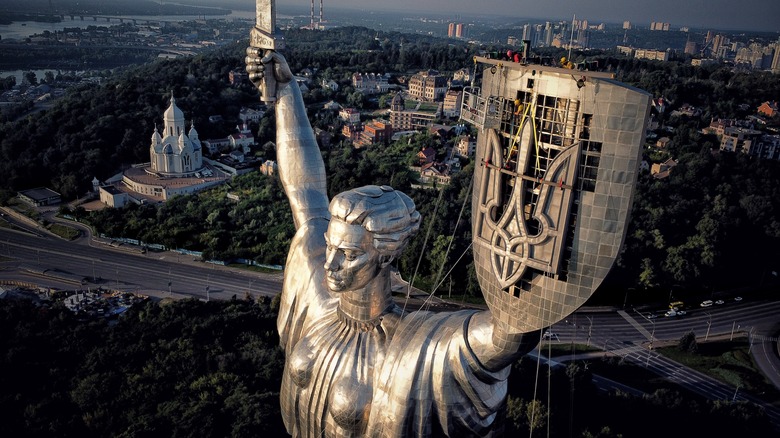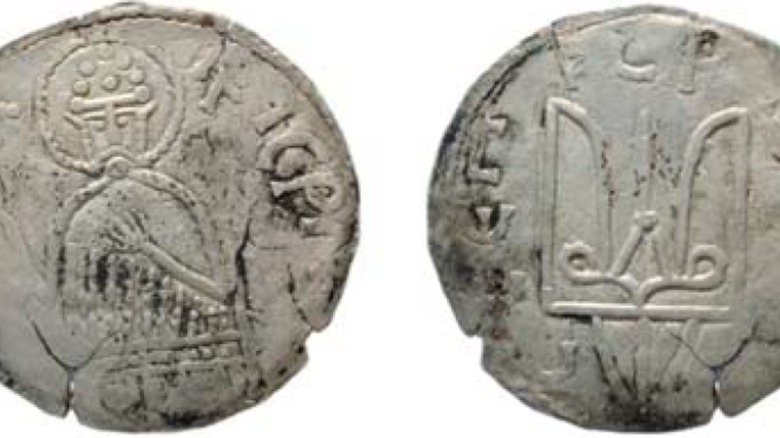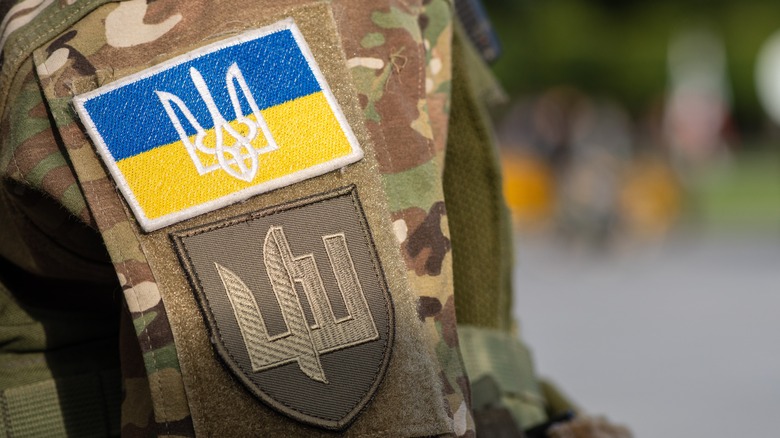What Ukraine's Trident Coat Of Arms Symbolizes
On August 6, 2023, it was widely reported that workers had made a notable alteration to the "Motherland" monument, a huge and imposing steel statue that looms over Kyiv, the embattled capital of Ukraine. The 40-year-old statue, which is 335 feet tall, depicts a robed woman who holds aloft a broadsword and shield and was originally erected to memorialize the Soviet victory over Nazi Germany in World War II. However, since the beginning of the Russo-Ukrainian war in 2014, when Russia annexed Ukraine's Crimea region, and particularly after the major escalation of the conflict in the spring of 2022 — when Russia ordered thousands of troops over the border into Ukraine but failed to take control of the NATO-backed country — one detail of the statue had rankled Ukrainians. The offense comes from a hammer and sickle on the statue's shield, the crest of the former Soviet Union which continues to be associated with the Russian Federation despite the country having officially adopted a new tricolor flag after the dissolution of the Soviet Union in 1991.
The hammer and sickle were to be removed and replaced with another symbol: a trident. Known in Ukraine as a "tryzub," it is a symbol with a long history going back to a specific historical king from the area, and which now — along with the national flag of yellow and azure blue — has come to symbolize both the sovereign nation and its people defiance in the face of war.
The ancient roots of the Ukrainian trident
In most Western cultures, the symbol of a trident is most closely related to Neptune, the Roman god of the sea who would use his great weapon to create earthquakes, stirring the seas and splitting the land, allowing water to fill the fissures he had created. But the Ukrainian tryzub reportedly comes from a different source. As outlined by the Internet Encyclopedia of Ukraine, the three-pronged symbol was used widely by tribes in the area of Eastern Europe hundreds of years ago, and as well as having adorned the coats of arms of various tribal dynasties has also been used by Ukrainian religious and political groups prior to the iteration that has spread widely during the Russo-Ukrainian war. The Kyiv Post reported the trident had even been found on artifacts in the Ukraine area dating as far back as 3000 to 5000 BCE during the Trypillian Neolithic era.
Specifically, the current design is based on that found on old currency that was discovered to have dated from the time of Prince Volodymyr the Great, who ruled the Kievan Rus region of what is today Ukraine in the 10th and 11 centuries CE. The exact meaning of the three-pointed trident is, however, still very much debated, with some claiming that the three points represent the Holy Trinity in Christianity, while other sources claim that the trident is, in fact, a swooping falcon, or that it represents the "three-dimensional world" (via The Kyiv Post).
A symbol rescued from history
There were two moments in Ukrainian history that led to the trident or tryzub becoming established as a key symbol for the country. The first came in 1918 when the symbol was officially adopted as the coat of arms of the Ukrainian National Republic when the country was initially recognized as a state independent of Russia. The coat of arms was taken up on the suggestion of the celebrated historian and politician Mykhailo Hrushevsky, who had recognized the tryzub's historical importance to the Ukraine region.
The trident's current form emerged much later, in 1992, after the fall of the Soviet Union and Ukraine first achieving sovereign independence. Amid the mass removal of symbols of Bolshevism and Lenin across Ukraine, the new government approved the design as the small coat of arms of the young country, with a yellow trident on a blue background, and is still in use in that capacity today.


